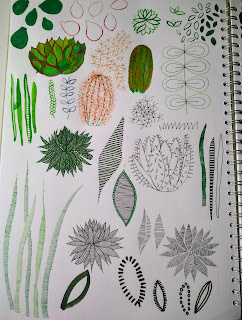Weeks 1 and 2
Of all the work in my sketchbook from over the summer, some
of the most successful was drawings, gouache and watercolour paintings I did of
cacti and succulents on my bedroom windowsill. They weren’t the most exciting
of subject matter, but I enjoyed representing them in a more detailed and
illustrative way, and I think my enjoyment came across in the outcome of my
drawing. Compared to the rest of my sketchbook, which was filled with larger,
more abstract and blocky designs, the two pages filled with windowsill plant
drawings were more labour-intensive and intricate.
 |
| Illustrative drawings from the summer. |
Although I am naturally more drawn to bold shapes, when it
comes to my own making process, I enjoy doing things which might take a long time,
but can give a really striking overall effect. This is one reason why I enjoyed
the exhibition of work by Waqas Khan, an artist who focuses on fine line
drawing, so much. Working in fine liner and also paper cutting are some of my
favourite techniques for drawing development.
With this in mind, I began my work at the start of term by expanding
on my illustrative drawing work. One thing which came up in my first one-to-one
tutorial was that all my drawings were of a very similar scale. To challenge my
drawing, I started working on A2 sheets, rather than in a sketchbook. I do
generally find that I prefer to work on sheets. Starting off in sketchbook to
gather ideas is fine, but very soon into a project I find that I want to work
more freely and sheets help me to be more experimental and bolder. I also find
that it is easier to see the development of my work when they are all laid out,
rather than having to turn the pages of a sketchbook.
The first thing I did therefore, was to take the
illustrations and motifs from my sketchbook and rework them on A2, including
more detail, focusing on filling one sheet with just one motif, and making the
drawings much bigger. I enjoyed doing this, but I found it took way too long,
and this was decreasing my motivation to be more experimental, because I felt I
had to dedicate all my time to finishing pages of line drawings. Whilst the
overall effects were certainly striking, I also didn’t feel like they worked
very well compositionally.
 |
| taking the motifs from my sketchbook and re-working the scale. |
To overcome this, I tried scanning in the drawings, changing
the size to add more variation and focus even more closely on specific details.
Then, I cut out the shapes and motifs and tried re-arranging them to create new
compositions. I found it hard to make these work – I wasn’t sure if it was because
of the drawings themselves, the mismatch of scales, the colours, or something
else, but I knew that I didn’t really like the way the images were working
together.
 |
| chaning the scale and cutting out the motifs to rearrange. |
I decided to change technique altogether to stimulate
something new. Instead of cutting out the drawings to arrange on a blank sheet
of paper, I made a grid of masking tape on a new A2 sheet and re-drew some of
the motifs I’d been working on within the tape boundaries. Then, when I removed
the tape there was an interesting set of lines running all over the page. This introduced
a sense of structure and separation between the images which I much preferred
to the layered effect which came from cutting up and collaging (although I do
really like collage).
 |
| using tape to introduce lines. |
I got some really good feedback from this work in the
tutorial session, which spurred ideas including looking at maps, aerial views
of mazes, and cutting out grids to layer on-top of sheets of motifs. Ideas
about changing the shape and width of lines were also helpful.
I found it hard to get going with my project over the last
two weeks. Despite being really inspired by my summer drawing work, I quickly
felt like I had reached a dead-end and wasn’t producing anything I wanted to
develop further. However, I think the most important thing I’ve realised over
the last fortnight is that it can be important to explore an idea, even if you
end up reaching a dead-end, because you then begin to retrace your ideas and go
off in other directions which might be more fruitful. I feel like this is what
has happened with my work, and this has been a valuable lesson to learn. I also
want to be a lot more experimental in the coming works, and bring in more
personality to my work by using maps from my home in the Lake District to
explore new line patterns.







Comments
Post a Comment